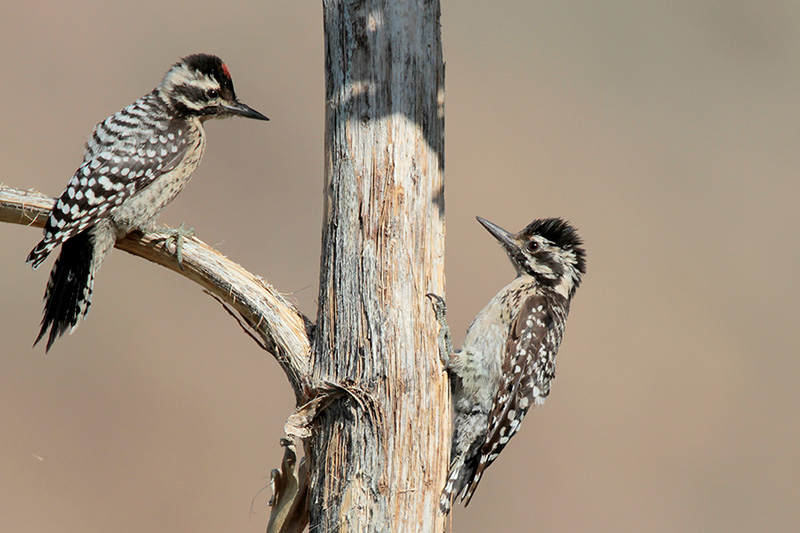Ladder-backed Woodpeckers (Dryobates scalaris) are known for their distinctive black-and-white striped pattern on their back, which resembles a ladder, and their bright red crown.
These woodpeckers are adapted to living in arid and semi-arid regions, such as deserts and dry woodlands, and have a unique foraging strategy that involves using their beak to chip away at bark and wood to find insects.
On this page
Breeding Male
Male Ladder-backed Woodpecker’s plumage is primarily black and white. They have a black upperside with white barring that resembles the rungs of a ladder.
Their underside is mostly whitish, grayish, or light creamy with black specks. Overall, their faces are whitish, with two black lines running towards the back of their neck, one from the bill and the other from the eyes.
Males sport red crowns. Their black bill is straight, chisel-like, and quite short.
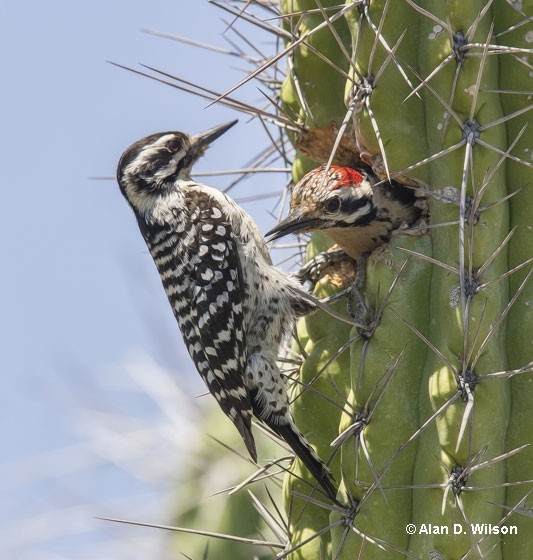
Pair of Ladder-backed Woodpeckers. The male has a red patch on the back of his head, the female doesn’t have a red patch. Photograph © Alan D. Wilson
Female
Female Ladder-backed Woodpeckers have almost the same plumage as males. Their uppersides are black with white barring and their undersides pale with black streaking.
However, females have a black crown instead of a red one. They have a buggy patch in front of their eyes and some females may have a darker tan wash on the belly.
Juvenile
These birds have only one brood per year with 2-7, mostly 3-4 white and unmarked eggs in a clutch. Both members of the pair take part in the incubation process, which lasts for about 13 days. Both parents take care of and feed the nestlings. Information about when the offspring leave the nest and reach independence is not known.
Juvenile Ladder-backed Woodpeckers look very similar to adults. As they age, male juveniles start to develop red feathers on their crowns.
This species is rather small and grows to be 6.3-7.1 inches long and reaches a weight between 0.7-1.7 ounces.
Habitat
Ladder-backed Woodpeckers prefer very dry and warm brushy areas, such as deserts, thickets, dry woods, and desert scrubs. Their preferred plants and trees differ from location to location, but they include agave, mesquite, catclaw, yucca, acacia, walkingstick cactus, and also juniper and pine.
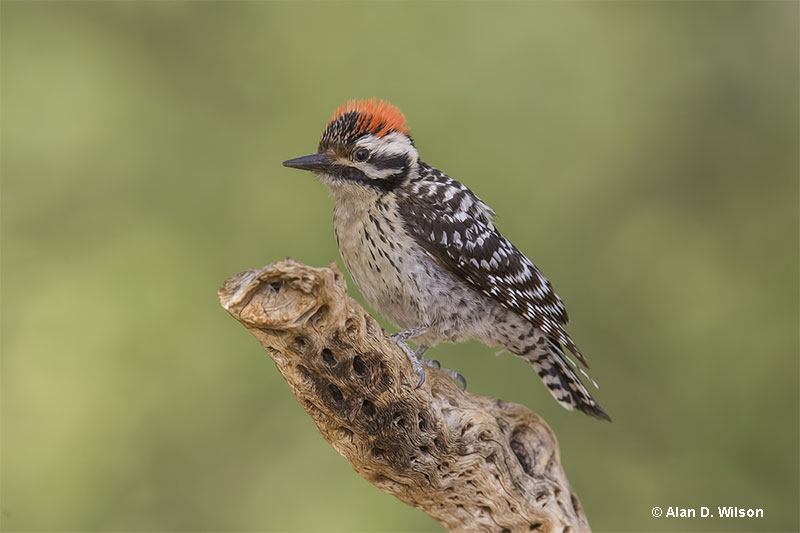
Ladder-backed Woodpeckers are cavity nesters. Both members of the pair excavate the nest cavity in trees such as willow or mesquite, in Joshua trees, or in giant cacti. Males do most of the excavating.
The finished nest cavity may be 7-14 inches deep, 3-4 inches across, and the opening 1.3-1.6 inches in diameter. No additional material is brought to the nest.
Diet
Ladder-backed Woodpeckers’ diet mostly consists of animal matter. They eat larvae of wood-boring beetles, adult insects, and spiders, and occasionally snack on cactus fruit. Some prey items include leafworms, ants, and caterpillars.
Unlike other woodpeckers, they don’t excavate deep into the wood to find food.
They forage on shrubs, cacti, trees, tall weeds, and sometimes on the ground. Males usually forage on trunks and branches, whereas females on bushes, cacti, and outer foliage.
Behavior
Ladder-backed Woodpeckers are monogamous, and the pairs stay together almost year-round, with pairs forming in the winter. Interestingly, members of the pair roost in separate cavities.
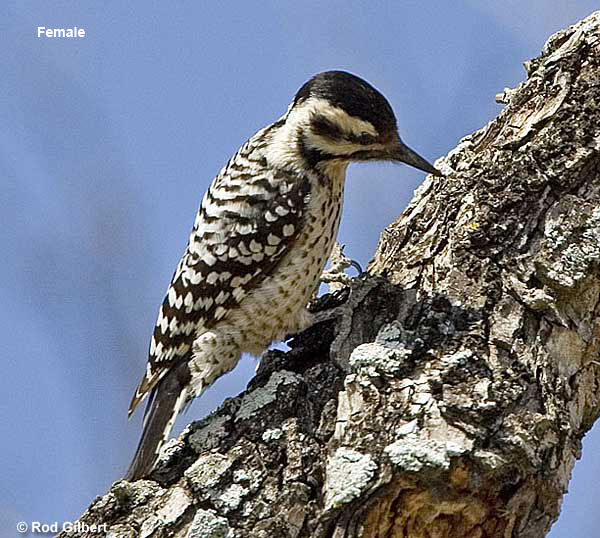
The birds are territorial towards other members of their species and will put on a display to defend their territory. This includes head turning and bobbing, raising head feathers, spreading tail and wings, and fluttering.
You can see them climbing up along tree trunks foraging for food, and sometimes walking or hopping on the ground.
Range (and seasonal changes)
Ladder-backed Woodpeckers range throughout the southwestern United States, Mexico, and Central America. They are year-round residents and do not migrate.
These woodpeckers are listed as a species of least concern on the IUCN Red List. Its population appears to be stable.
Wing shape
Ladder-backed Woodpeckers have a wingspan of 13 inches, which is almost twice the length of their body.
Their wings are broad and have slots between their primary feathers, which helps with quick take-off, maneuverability at low speeds, and quick acceleration – perfect features for navigating their environment.
You can recognize a Ladder-backed Woodpecker by its swift wingbeats and undulating flight.
Fun Facts
- Ladder-backed Woodpeckers are known to hybridize with Nuttall’s Woodpeckers where their ranges overlap.
- Ladder-backed Woodpeckers are named after the distinctive ladder-like pattern on their back, which consists of black and white bars.
- Ladder-backed Woodpeckers, like many other woodpecker species, have a unique adaptation that allows them to cling to the sides of trees and cacti while foraging for insects. Their stiff tail feathers act as a prop and their toes create an X-pattern, which gives them extra stability during foraging.
- Ladder-backed Woodpecker’s drum about 30 taps per second.
Call
Ladder-backed Woodpeckers have a few different sounds and calls to communicate. The most common call is a loud pik call, which the pair uses to stay in contact with each other.
They sometimes also rattle, chatter, and use other, more uncommon calls, such as twek, kwah, wicka, and others. Their drumming is rather rapid but short.
Similar Species

Downy Woodpecker Male
Ladder-backed Woodpeckers and Downy Woodpeckers are similar in size. Both have some red on their heads, but Downy Woodpeckers’ red patch starts at the back of their heads, while Ladder-backed Woodpeckers’ starts above their eyes.
Another big difference comes in the form of plumage. Ladder-backed Woodpeckers have barred, ladder-like patterns (hence the name) on their backs, while Downy Woodpeckers have a white back, whit some white parts on their wings.
Related: Types of Woodpeckers in North America
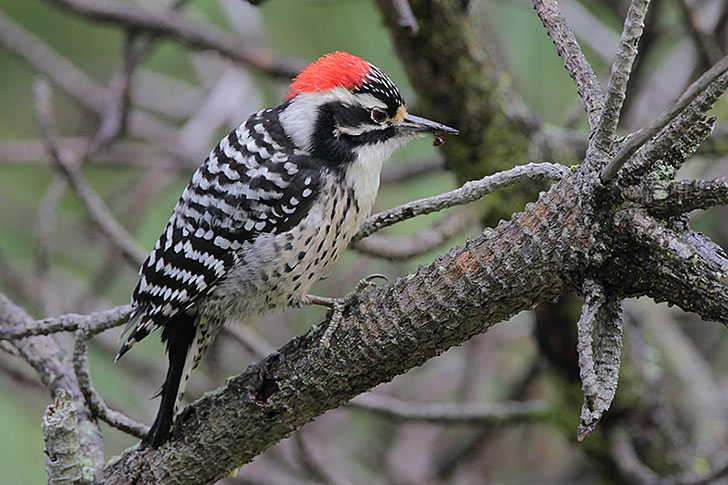
Nuttall’s Woodpecker
When it comes to similarities, Nuttall’s Woodpeckers bear the closest similarity to Ladder-backed Woodpeckers. Both woodpeckers are similar in size.
Both birds have red on the backs of their heads and barred backs and wings. Nuttall’s Woodpeckers have a small patch of white on the area between their bills and eyes, and their chest is white in color, as opposed to Ladder-backed Woodpeckers’ speckled plumage.
It’s important to remember that these woodpeckers have different ranges (with some overlapping parts) – Nuttall’s Woodpeckers are mainly found in California, while Ladder-backed Woodpeckers can be found in Mexico, some other parts of Central America, and in southern parts of the U.S.
Frequently Asked Questions
Are Ladder-backed Woodpeckers rare?
Ladder-backed Woodpeckers are uncommon to common within their range. However, they are elusive and may be hard to spot.
Where are Ladder-backed Woodpeckers found?
Ladder-backed Woodpeckers are found throughout dry and brushy areas, such as deserts, desert scrub, and dry woods throughout the southwestern United States, Mexico, and Central America.

